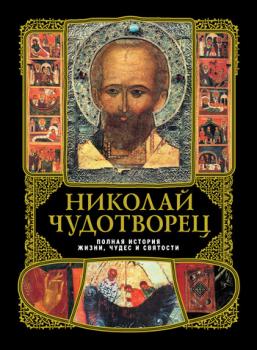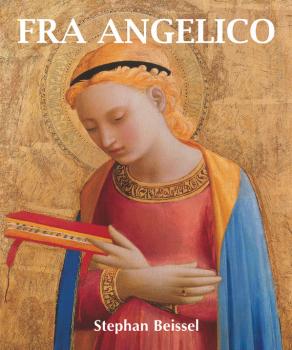Религия: прочее
Различные книги в жанре Религия: прочееПреподобный Сергий Радонежский: Жизнеописание, молитвы, святыни
В книгу вошли жизнеописание и история обретения мощей святого, молитвы преподобному Сергию Радонежскому и рассказ о Троице-Сергиевой лавре.
Николай Чудотворец: Полная история жизни, чудес и святости
Самое полное описание земной жизни и чудес Николая Чудотворца, храмов, посвященных ему в России. Новое издание не переиздававшегося более века классического труда богато иллюстрировано и дополнено современной информацией в части, касающейся храмов. Многие изображения практически неизвестны в России, а сама книга долгое время оставалась редчайшим раритетом.
Серафимов день (сборник)
Наиболее полный сборник документальных рассказов иеродиакона Никона (Муртазова), чей жизненный путь с юности связан со Христом и монашествующими.
Иисус Христос. Рождество, Пасха, Троица в русской живописи и иконописи
Краткое иллюстрированное изложение Нового Завета Священного Писания, проиллюстрированное иконами и произведениями русских художников. При подготовке издания были использованы изображения русских икон, а так же произведения русских художников: В.М. Васнецова, В.Л. Боровиковского, Г.Г. Гагарина, В.И. Отмара, А.А. Иванова, И.Н. Крамского, Н.П. Шаховского, Н.А. Бруни, К.П. Брюллова, А.Е. Егорова, М.В. Нестерова.
Встречая сомнения. Книга для верующих – адвентистов «на грани»
Сегодня многие христиане сражаются с серьезными сомнениями, касающимися их веры и их церкви. Это касается и христиан – адвентистов седьмого дня, в особенности в западном мире. Многие оставляют свою церковь или же оказываются «на грани» того, что они уйдут из церкви. Эти люди пытаются решить, что они сделают: тоже уйдут или найдут мужество остаться. Книга, которую вы держите, написана для таких людей.
The Splendor of English Gothic Architecture
This book explains and celebrates the richness of English churches and cathedrals, which have a major place in medieval architecture. The English Gothic style developed somewhat later than in France, but rapidly developed its own architectural and ornamental codes. The author, John Shannon Hendrix, classifies English Gothic architecture in four principal stages: the early English Gothic, the decorated, the curvilinear, and the perpendicular Gothic. Several photographs of these architectural testimonies allow us to understand the whole originality of Britain during the Gothic era: in Canterbury, Wells, Lincoln, York, and Salisbury. The English Gothic architecture is a poetic one, speaking both to the senses and spirit.
Hans Memling
Little is known of Memling’s life. It is surmised that he was a German by descent but the definite fact of his life is that he painted at Bruges, sharing with the van Eycks, who had also worked in that city, the honour of being the leading artists of the so-called ‘School of Bruges’. He carried on their method of painting, and added to it a quality of gentle sentiment. In his case, as in theirs, Flemish art, founded upon local conditions and embodying purely local ideals, reached its fullest expression.
Fra Angelico
Secluded within cloister walls, a painter and a monk, and brother of the order of the Dominicans, Angelico devoted his life to religious paintings. Little is known of his early life except that he was born at Vicchio, in the broad fertile valley of the Mugello, not far from Florence, that his name was Guido de Pietro, and that he passed his youth in Florence, probably in some bottegha, for at twenty he was recognised as a painter. In 1418 he entered in a Dominican convent in Fiesole with his brother. They were welcomed by the monks and, after a year’s novitiate, admitted to the brotherhood, Guido taking the name by which he was known for the rest of his life, Fra Giovanni da Fiesole; for the title of Angelico, the “Angel,” or Il Beato, “The Blessed,” was conferred on him after his death. Henceforth he became an example of two personalities in one man: he was all in all a painter, but also a devout monk; his subjects were always religious ones and represented in a deeply religious spirit, yet his devotion as a monk was no greater than his absorption as an artist. Consequently, though his life was secluded within the walls of the monastery, he kept in touch with the art movements of his time and continually developed as a painter. His early work shows that he had learned of the illuminators who inherited the Byzantine traditions, and had been affected by the simple religious feeling of Giotto’s work. Also influenced by Lorenzo Monaco and the Sienese School, he painted under the patronage of Cosimo de Medici. Then he began to learn of that brilliant band of sculptors and architects who were enriching Florence by their genius. Ghiberti was executing his pictures in bronze upon the doors of the Baptistery; Donatello, his famous statue of St. George and the dancing children around the organ-gallery in the Cathedral; and Luca della Robbia was at work upon his frieze of children, singing, dancing and playing upon instruments. Moreover, Masaccio had revealed the dignity of form in painting. Through these artists the beauty of the human form and of its life and movement was being manifested to the Florentines and to the other cities. Angelico caught the enthusiasm and gave increasing reality of life and movement to his figures.
Icons
Icon painting has reached its zenith in Ukraine between the 11th and 18th centuries. This art is appealing because of its great openness to other influences – the obedience to the rules of Orthodox Christianity in its early stages, the borrowing from Roman heritage or later to the Western breakthroughs – combined with a never compromised assertion of a distinctly Slavic soul and identity. This book presents a handpicked and representative selection of works from the 11th century to the late Baroque period.
Пробуждение души. Секреты личного духовного пробуждения
Под пробуждением обычно понимают коллективное движение, начинающееся в среде верующих людей, переживающих духовное обновление, и влекущее за собой обращение к вере масс неверующих. К сожалению, лишь немногие понимают, что истинное духовное пробуждение, прежде всего, дело личное. Влияние, которое оно оказывает на общество, является следствием личной встречи с Богом конкретного человека. Если хотя бы одна душа не переживет свое личное пробуждение, как оно может прийти в церковь, город или страну?









